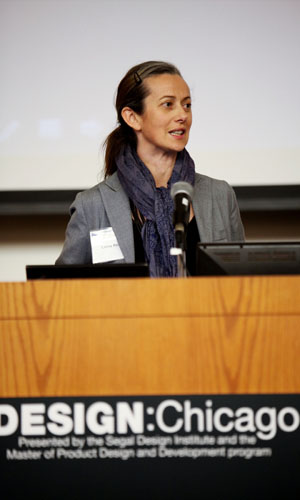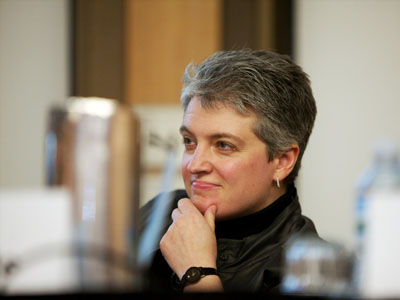Design:Chicago Panelists Talk Innovation in Healthcare
A prosthetic leg that looks fashionable. An easy-to-use syringe. An inexpensive suction device to heal wounds in developing countries.
These healthcare devices, presented by Fast Company senior editor Linda Tischler at the annual Design: Chicago panel at Northwestern University, are some of the best designed innovations in the industry.
But how does that innovation happen? A panel of designers and managers, who spoke to a packed room as part of Design: Chicago on April 14, offered their ideas and experiences.
 For Lorna Ross, design manager in the Center for Innovation at the Mayo Clinic, innovation is “having things you never imagined.” As part of the center at the clinic she helps design everything from finance operations to patient experiences. Her team routinely works with different groups in the hospital to take their vision and turn it into the right question.
For Lorna Ross, design manager in the Center for Innovation at the Mayo Clinic, innovation is “having things you never imagined.” As part of the center at the clinic she helps design everything from finance operations to patient experiences. Her team routinely works with different groups in the hospital to take their vision and turn it into the right question.
“We try to teach people our process to create a culture of innovation,” she said.
Ross’ team routinely tries to improve the Mayo’s patient experience. They’ve created simpler, more comfortable kits for stool sample collection, and they’ve relocated the doctor-patient consultation to a table, where patients are known to ask better questions.
Ross says they try to create a compass to help better navigate the patient experience, since no one can ultimately know how experiences will change.
“If you can describe it, then it’s not the future,” she said. “What matters is imagination.”
Creating a better guide for the patient experience is also the goal of GE Healthcare, says Bob Schwartz, general manager of global design at the company.
“We want you to have the best, most involved, least anxiety-producing experience,” he said.
GE designers have trained with Second City improv performers to learn how to “accept and add ideas with others,” and they approach design though a philosophy of the “magic of science and empathy”: creating functional devices that also have emotional benefits. Recent devices include an aesthetically pleasing CAT scan machine -- “Why can’t it look like a BMW that you want to get in and drive away?” Schwartz said – and an infant warmer for developing countries that’s 75 percent cheaper.
It’s responding to those global markets and trends that guides Hospira, said Sumant Ramachandra, senior vice president of research and development and medical affairs and chief scientific officer for the company. They’ve hired designers around the world in order to “tap into local talent to build for that specific market.”
Because the healthcare industry is highly regulated, designers need to create incremental innovations – as is the case with Hospira’s new Marrow Miner, a device developed by a professor at Stanford University that more easily harvests marrow from donors, making the process quicker and less painful.
But when making new devices like this, Ramachandra said, you must think not only of the first version but of the entire life cycle of the product.
“Your vision is to maker version 100 in your lifetime,” he said.
 That extended vision – understanding the ultimate potential of a product – also led to one of HermanMiller’s best-known products. Gretchen Gscheidle, director of insight and exploration at HermanMiller, told the story of a product that was developed at the company in the 1980s that focused on the country’s aging population.
That extended vision – understanding the ultimate potential of a product – also led to one of HermanMiller’s best-known products. Gretchen Gscheidle, director of insight and exploration at HermanMiller, told the story of a product that was developed at the company in the 1980s that focused on the country’s aging population.
HermanMiller already had a foothold in the ergonomic office market, and they wanted to extend that comfort to senior citizens who spent much of their day sitting. The designers spent years creating a recliner that felt smooth, easy, and natural, but ultimately, the market wasn’t there. Designers Bill Stumpf and Don Chadwick kept working at it for years, however, and ultimately the design evolved into the Aeron chair: the most well-known ergonomic office chair ever made.
Allowing for that element of change – transferring that innovative thinking into a different market – allowed the design to become successful, she said.
“Innovation is lasting, transferable, and part of the future,” she said.